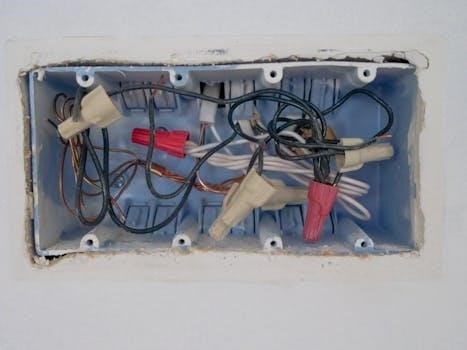Overview of Electrical Switches
In electrical engineering, a switch is a crucial component that controls the flow of electricity within a circuit. It acts as a gate, either allowing current to pass through or interrupting the flow. Switches are essential for turning devices on and off, or selecting different circuit pathways. The most common type is an electromechanical device.
What is an Electrical Switch?
An electrical switch is a fundamental component in electrical circuits, serving as a device to control the flow of electricity. In essence, it acts as a gate, either completing a circuit to allow current to flow, or breaking a circuit to stop the flow of current. The most common switches are electromechanical, using physical movement to open or close electrical contacts. They are essential for operating various electrical devices, from simple light switches to complex industrial machinery. The primary function of an electrical switch is to provide a controlled means of connecting or disconnecting parts of an electrical circuit. This can be achieved manually, through physical movement, or automatically using electronic components. Switches can have different configurations, like single-pole or double-pole, and can be single or double-throw, allowing for various control options in an electrical system. They enable engineers and electricians to design circuits that perform specific functions, ensuring safety and efficient operation. The core principle is to interrupt or establish an electrical path as required for the intended operation of the circuit and its components.

Types of Electrical Switches
Electrical switches are broadly classified into two main categories⁚ mechanical and electronic. Mechanical switches rely on physical contact to make or break circuits, while electronic switches use semiconductors to control current flow. Each type offers distinct advantages for different applications.
Mechanical Switches
Mechanical switches are physical devices that require manual or mechanical force to operate. These switches use physical movement of contacts to establish or interrupt an electrical connection. They are widely used in various applications due to their simplicity and reliability. Mechanical switches can be further classified based on their structure, contact arrangement, and method of operation. Some common types include toggle switches, pushbutton switches, rotary switches, and slide switches. These switches can also be categorized by their number of poles and throws, such as single pole single throw (SPST), single pole double throw (SPDT), and double pole double throw (DPDT). The mechanism of operation usually involves a lever, button, or other actuator that moves internal contacts, completing or breaking the electrical circuit. Mechanical switches are robust and can handle relatively high currents and voltages, making them suitable for numerous applications from basic on/off controls to complex switching sequences. They’re the most common type of switches used in a wide array of applications.
SPST (Single Pole Single Throw)
An SPST, or Single Pole Single Throw switch, is the most basic type of mechanical switch. It features a single input terminal, or pole, and a single output terminal, or throw. Essentially, an SPST switch acts as a simple on/off switch. When the switch is in the ‘on’ position, the internal contacts are closed, allowing current to flow through the circuit. Conversely, when the switch is in the ‘off’ position, the contacts are open, interrupting the current flow. SPST switches are commonly used in household applications, such as light switches, where they control the power to a single device or circuit. These switches are straightforward to understand and implement, making them very popular for simple circuit control. They are also known for their reliability and durability. Their simplicity makes them one of the most frequently used switch types in the electrical world. The SPST switch has only two states⁚ closed, which completes the circuit, and open, which breaks the circuit.
SPDT (Single Pole Double Throw)
The SPDT, or Single Pole Double Throw switch, is a step up in complexity from the SPST switch. It features one input terminal or pole, but two output terminals, or throws. This allows the SPDT switch to direct the flow of current to one of two different paths, making it a versatile component in electrical circuits. Unlike an SPST switch, which only has on and off states, an SPDT switch has two on states. The common input terminal is connected to one of the output terminals at any given time. Mechanically, an SPDT switch usually has a toggle or lever that moves to select which output terminal the input is connected to. SPDT switches are often used in applications where a circuit needs to be switched between two different functions or loads. They can be used in circuits for selecting between two different power sources, or for reversing polarity. They offer more flexibility compared to SPST switches because of their dual output capability and are also known as 2-way switches.
Electronic Switches
Electronic switches represent a significant departure from their mechanical counterparts, operating without physical movement of parts. Instead, they rely on the manipulation of semiconductor materials to control the flow of electricity. Common examples include transistors, MOSFETs, SCRs, TRIACs and IGBTs, each leveraging different properties of semiconductor physics to achieve switching functionality. These switches are typically controlled by electrical signals rather than manual force. Electronic switches are capable of very high-speed operation, switching much faster than mechanical switches. This makes them ideal for modern electronics applications where rapid switching is critical. Additionally, electronic switches tend to have a longer lifespan and are more reliable because they do not suffer from mechanical wear and tear. Furthermore, they can be easily integrated into electronic circuits, allowing for more complex and automated control systems. They are essential in digital logic circuits, power management systems, and many other applications where precise and fast switching is required. Electronic switches, such as transistors, can either allow or prevent the current from passing through.

Switch Actuation Methods
Switch actuation methods refer to the ways in which a switch is physically activated. These methods include toggle switches, which use a lever, and pushbutton switches, which are activated by pressing a button. Other methods include rotary, slide, and touch-based switches.
Toggle Switches
Toggle switches are a common type of switch characterized by a protruding handle or lever that is manually moved to control the electrical circuit. These switches are hinged and typically have two positions, corresponding to “on” and “off” states. They are widely used in various applications due to their simple operation and clear indication of their current state. The movement of the toggle lever opens or closes the internal contacts, thus controlling the flow of electricity. Toggle switches are often found in household appliances, industrial equipment, and automotive applications. They are robust and reliable, designed to withstand frequent use. The distinct click or snap as the lever is toggled provides tactile feedback to the user. This type of switch is generally easy to install and maintain, making it a practical choice for many electrical circuits. Additionally, toggle switches come in different sizes and current ratings to suit various power requirements. They are a fundamental component in electrical control systems.
Pushbutton Switches
Pushbutton switches are another fundamental type of electrical switch, distinguished by their activation mechanism involving pressing a button. These switches are designed to create or break an electrical connection when the button is pressed and often return to their initial state once released. They are commonly used for momentary applications like starting a motor or activating a signal. However, some pushbutton switches can latch, maintaining their state until pressed again. Pushbutton switches are available in various forms and sizes, suitable for different current and voltage requirements. They can also include features like illumination, which provides a visual indication of their status. These switches are frequently found in control panels, electronic devices, and machinery. The tactile feedback provided by the button press allows for easy and intuitive operation. Pushbutton switches are designed for reliability and durability, able to withstand repeated use. Some variants also offer protection against environmental factors such as dust and moisture. They are a versatile and essential element in electrical control systems.

Switch Configurations
Switch configurations determine how a switch behaves in its resting state. The two primary configurations are normally open (NO), which doesn’t allow current to flow, and normally closed (NC), which allows current to flow. These configurations are crucial for proper circuit design.
Normally Open (NO) and Normally Closed (NC)
In electrical circuits, switches are often categorized by their resting state, which is either normally open (NO) or normally closed (NC). A normally open (NO) switch, in its default state, does not allow current to flow through the circuit. Think of it as an open gate, preventing the electricity from passing. Current only flows when the switch is activated or closed. This type of switch is commonly used in applications where you need to initiate or complete a circuit. Conversely, a normally closed (NC) switch, in its default state, permits current to flow freely through the circuit, like a closed gate. The current is interrupted only when the switch is activated, which opens the circuit and stops the flow. NC switches are often used in safety circuits, where a break in the connection triggers an alarm. Understanding the difference between NO and NC switches is vital for designing effective and safe electrical systems. Choosing the correct type of switch is critical for the intended function of the electrical system.
